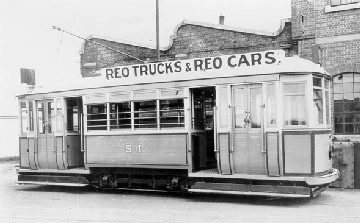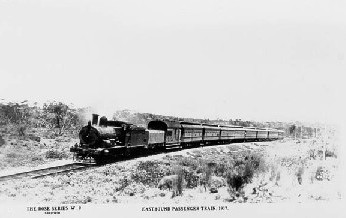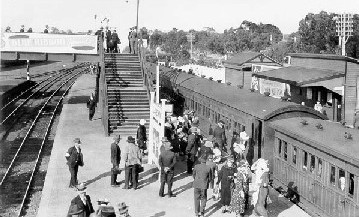
But Curtin was no stranger to travel. As Secretary of the Timber Workers Union in Victoria he had toured that state enduring the basics of train travel where overnight services provided a place to sleep as well as a means of transport. It is doubtful that Curtin got much sleep on these overnight trains as he lay down on the hard seats, rather than the comfortable beds that he would enjoy on trains in the years ahead.
In the same role he travelled to Tasmania - by steamship across Bass Strait to Launceston, then by train to Hobart. These trips to Tasmania were to change his life as it was there that he met Elsie Needham, the young woman who would become his wife. He wrote to her about his resignation from the Timber Workers Union job in November 1915 saying that he could no longer 'travel from office to mill, sleeping in trains. ..' [1]
Life in the suburbs of Melbourne meant that Curtin used Melbourne's extensive tram system to travel around the city. With his active life it is not surprising that his future wife was to say 'I suppose I'll have a tram ride for my honeymoon.' [2] And she was right! Their wedding was in the run up to a Federal election, and meant the postponement of their 'real' honeymoon.
A tram similar to the one in which the Curtin wedding party travelled to Perth for tea and cakes at a cafe after the marriage ceremony. Afterwards, the newlyweds caught another tram back to their home.
Photograph: B Dunn collection. Held by P Rogers
When Curtin moved to Western Australia he sailed on the 'Katoomba'. There
was little choice of transport for him as the Trans-Australian Railway
was still in the construction stage. However by April 1918, when Curtin
was sponsored by the WA Government to attend a Press Censorship Conference
of newspaper editors in Melbourne, the new railway between Kalgoorlie
and Port Augusta was complete, thus it was now possible to travel between
east and west by train. It was to be the first of many trips for Curtin
across Australia on the railroad, and during his lifetime this meant a
number of changes of trains at various stops.
Learn more about the Kalgoorlie-Port Augusta railway.
View a film clip of the first passenger train to cross the Nullarbor in 1917
The eastbound passenger train, 1917. The journey between Perth and Melbourne took three and a half days and involved several changes of train.
Photograph: Australian Historical Society Archives
Trains with side door carriages, also known as 'dog-boxes', were the typical suburban rail passenger trains used along the railway into Perth.
Photograph: P Rogers Collection
Although Curtin was unsuccessful in his attempts to enter Federal Parliament
in 1919 and 1925, his involvement with the labour movement and in particular
with the Australian Journalists' Association (AJA) and the Australian
Labor Party provided opportunities for travel.
For instance, he headed to Melbourne as one of the WA delegates to the All Australian Trades Union Conference in June 1921, making such an impression that the Bulletin newspaper of July 1921 stated 'One of the outstanding figures at the Trades Union Conference was Jack Curtin, formerly the boy orator of the Melbourne Trades Hall'. Later, as President of the Western Australian District of the AJA, Curtin attended the Annual Council of the AJA, a three day meeting held at the Sydney Press Club in February 1923. Then, in 1927, Curtin was appointed by the Commonwealth Government to serve on the Royal Commission on Child Endowment that met in most state capitals and in Canberra.
Curtin missed his family during these absences from home, particularly on the initial outward leg of the journey.










